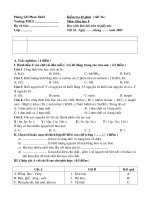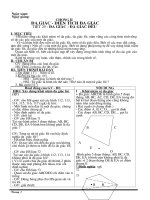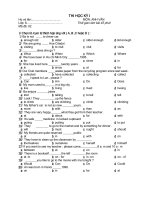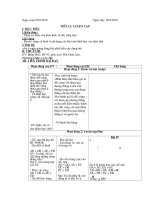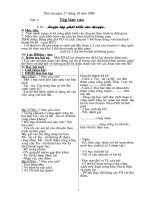Tài liệu Chapter 8: Accounts receivable management pdf
Bạn đang xem bản rút gọn của tài liệu. Xem và tải ngay bản đầy đủ của tài liệu tại đây (271.61 KB, 25 trang )
Chapter 8
Accounts receivable management
Outline of the chapter
Objective of receivable management
Credit policies
Credit standard policies
Credit term policies
Credit period
Cash discount
Credit policies with default risk
Objective of receivables
management
Receivables come from sales in credit
Credit sales Increasing revenue Increasing profit
Credit sales increasing receivables Increasing
operating costs
Objective of receivables management is:
to determine whether increasing in revenue
and profit is large enough to offset increasing
in costs, or
to determine whether saving in cost is large
enough to offset decreasing in profit.
Objective of receivables management
Sales in credit
Revenues increase Receivables increase
Profits increase Increase in costs related to receivables
Compare
increase in
profit and in
costs
Determine credit
policies
Opportunity costs
Credit policies
Credit standards
Credit terms
Credit period
Cash discount
Credit policies with influence of default risk
Credit standards
Credit standards – the minimum quality of
credit worthiness of a credit applicant that
is acceptable to the firm.
Credit standard policy may be:
Lowering – lower the standards or easier in
accepting sales in credit
Highering – Higher the standards or more
difficult in accepting sales in credit
Impact of a lower credit standard
Lowering
credit
standard
Increasing
in sales
Increasing in
receivables
Increasing in
opportunity
costs
Increasing
in profit
Whether
increasing in
profit is offset
increasing in
cots
Impact of a higher credit standard
Higher
credit
standard
Decreasing
in sales
Decreasing in
receivables
Saving in
opportunity
costs
Decreasing
in profit
Whether
saving in
costs is offset
decreasing in
profit
Suppose that ABC. Ltd’ s product sells for $10 a unit, of which $8 represents variable
costs before tax. Annual sales are presently running at level of $2.4 million and
opportunity cost of carrying the additional receivables is 20 percent before tax. The
relaxation in credit standards is expected to produce a 25 percent increase in sales
but average collection period is increased to 2 months. Should the firm relax its credit
standard?
Profitability of additional sales
Additional sales = 2.4 x 25% = $0.6 million =$600,000
Additional sales in unit = 600,000 / 10 = 60,000
Additional profit = 60,000(10 – 8) = $120,000
Opportunity cost of receivables
Receivable turnover = 12 months/Average collection
period = 12 / 2 = 6
Additional receivables = Additional sales revenue/
receivable turnover = 600,000 / 6 = $100,000
Investment in additional receivables = 100,000(8/10) =
$80,000
Required before-tax return on additional investment=
80,000 x 20% = $16,000 (opportunity cost)
Policy determination
Additional profit from relaxation of credit
standards = $120,000
Opportunity cost originated from relaxation
of credit standards = 16,000$
Additional profit > Opportunity cost
The company should lower its credit
standards

